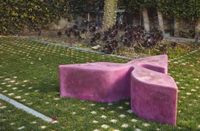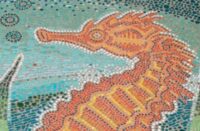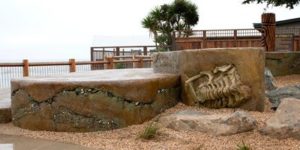
Robin Brailsford’s online resume lists her as “Artist, Inventor, Aesthetic Engineer.” The word “concrete” doesn’t makes its first appearance until the third page, but nonetheless, Brailsford has made a huge contribution to the art and science of decorative concrete through her patented invention, LithoMosaic.
Brailsford, 61, grew up in an artistic family in an old-fashioned oceanfront town on Massachusetts’ North Shore. Her mother, Frances Wosmek, who died in 2014 at age 96, wrote and illustrated children’s books and was the first card designer hired by American Greetings. Brailsford’s father was a master mariner, a sea captain originally from London.
Brailsford’s hometown had nary a concrete block in sight. “There really isn’t any concrete in New England,” she says. “The curbs, bridges, everything is made out of stone.”

She went to graduate school in New Mexico for a sculpture degree, then realized that wasn’t the best location for an artist. “The problem with New Mexico was that everybody was an artist and nobody was a client. I found that California was what I was looking for.”
California discoveries
Some of Brailsford’s public art projects in California involved setting regular mosaic tiles on Duraboard, an insulating board made by Unifrax. “Then they were set into the sidewalk in a medallion,” she says. “Those were wonderful but they were very limited in scale. Duraboard is only 3-by-5 feet.”
For the Downtown Transit Mall in Santa Monica, Brailsford wanted stenciled designs in six intersections. “So I was ranging around looking for how I could do what I wanted to do,” she recalls.
She discovered a process called Lithocrete, invented by Ron Shaw of the California concrete construction company Shaw & Sons. Lithocrete is a natural granite and/or stone finish permanently embedded into the surface of structural concrete. That technique helped her achieve her goals on the Santa Monica project.
Next, Brailsford used the Lithocrete process on a 1,000-foot-long “river” at a bus transit mall in Phoenix. To achieve an artistic river effect, she hand-tossed all the aggregates in a meandering form. “It was a very hard job because I had to toss the aggregate as fast as possible ahead of the five-man concrete crew following me that was troweling the aggregates as I threw them,” she recalls. “It was 100 degrees and I had 50 buckets of aggregate I was tossing. I thought, ‘There’s got to be a better way!’”
Placing Lithocrete involves a technique of scattering aggregate on the surface of wet concrete. Brailsford wanted a way to create a deliberate pattern in the comfort of a studio that both the artist and the client could look at and consider, and which could be placed in monolithic concrete pours. “It took five or six years of research and development to get the magic combo of glues and mesh and sequence. I did a lot of work with Shaw & Sons and T.B. Penick (& Sons), and one day we got it right.”
LithoMosaic as public art
Brailsford, along with Ron Shaw, secured the patent about five years ago. LithoMosaic is now in the lexicon and is specified by architects from Alaska to Florida. Originally, Shaw & Sons wanted to write in the contract that Brailsford install every LithoMosaic.
“But I wanted to see what other artists could do with it as a new art technique,” she says. “I do get a royalty for every LithoMosaic that goes in, which buys me freedom to create, and it’s exciting to see where other artists can take it.”
To her, LithoMosaic is not only the future of mosaics, it’s the future of concrete. “You can work big, so it has the attributes of concrete — the strength, the durability, the scale. And then you also have the artists who don’t have to know about any of those things at all, but are completely in charge of designing a superb work of public art.”
The LithoMosaic technique involves creating a large-scale design and blowing it up to full size. Next, a piece of plastic is placed over the design, with a piece of mesh over the top of it. Using a specific glue, the tiles are adhered upside down on top of the design drawing. The LithoMosaics are then shipped as a whole piece.
At the site, the concrete is poured, troweled flat and the LithoMosaic is laid upside down so the tiles are under the surface of the concrete. “The water in the concrete releases the glue and the mesh is pulled back and the tiles are set in the concrete,” Brailsford says.
One size does not fit all
LithoMosaic is not a good fit for small patterns or for backyard projects. The technique does work extremely well for transportation corridors, parks, public plazas and other places where large, monolithic concrete pours would be appropriate and a bold aesthetic is desired for wayfinding, sense of place, intrigue and beauty.
“The tiles have to be substantial in size, and you need a 1/4 inch between the tiles so that the concrete cream can come up between them,” she says. “Usually we do very large projects made up of sections that are 4-by-8 feet.”
Brailsford’s technique has been used for public art projects in Nevada, Texas, Arizona and North Carolina and in California in Santa Monica, Irwindale, Lemon Grove and Long Beach. Her “Edendale Botanica” for The Trust for Public Land in Los Angeles has eight curving LithoMosaic benches with floral imagery that celebrates the area’s natural history. A promenade down Main Street in Lemon Grove includes giant LithoMosaic lemon slices and fruit crates. Also in Los Angeles, the Goldline light rail commissioned a 10,000-square-foot LithoMosaic element for the station.
Brailsford has given presentations on LithoMosaic and received honors throughout the nation, including LEED platinum certification for the Desert National Wildlife Visitor Center in Las Vegas.
Concrete and the artist
Though Brailsford has spent her life seeking out artistic inspiration and collaboration, she never imagined that concrete would become her primary medium.
“Growing up, the two art materials I didn’t like were silver and concrete, and those turned out to be the most important to my artistic career,” she says.
“I also really enjoy collaborating with landscape architects and engineers in the planning stage on really big and difficult projects. And then the fabulous one-on-one collaboration with the guys in the field, masters all. I also enjoy the unique collaboration between a woman artist and the male-dominated world of concrete construction.”
www.lithomosaic.squarespace.com


























